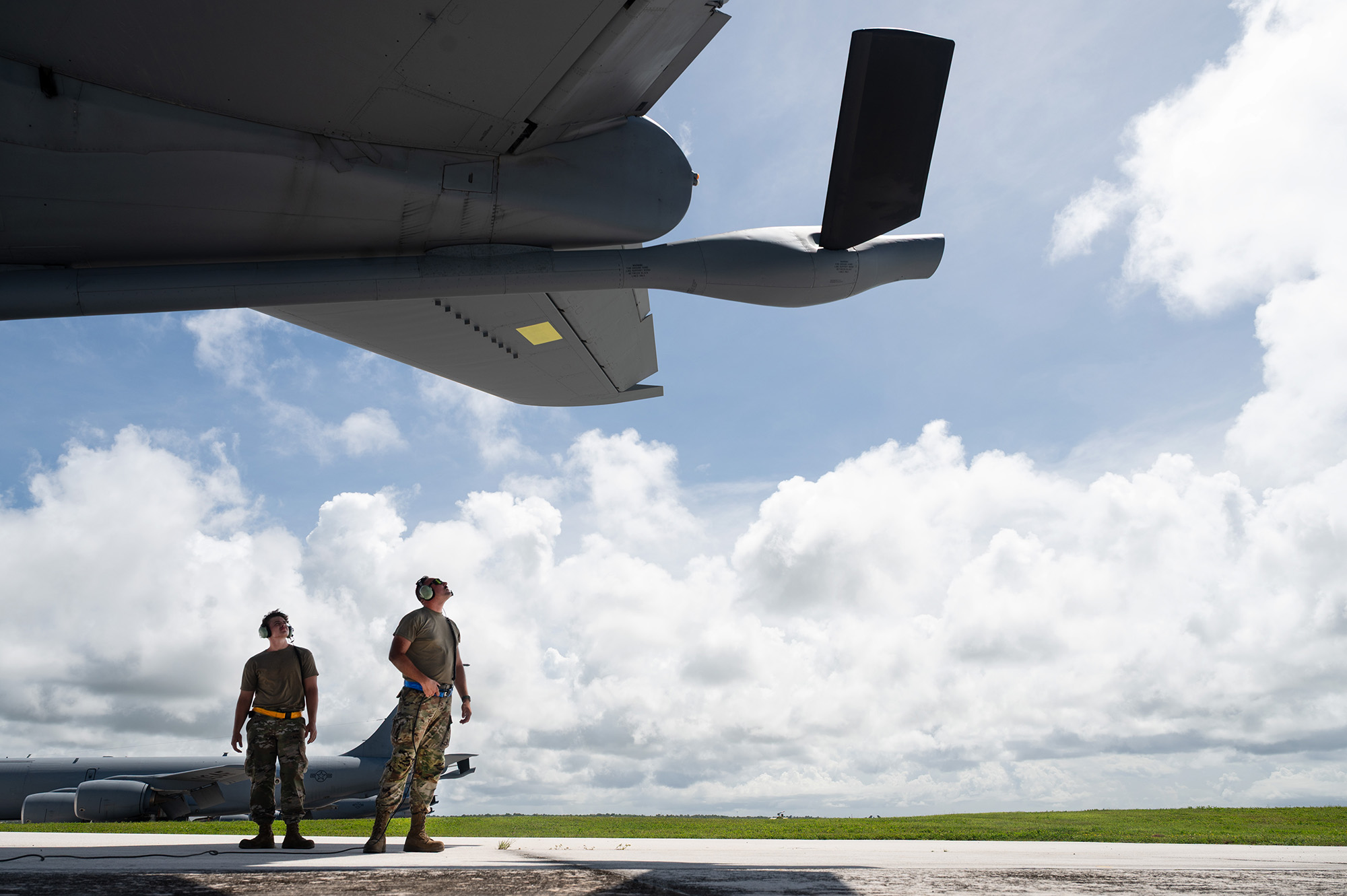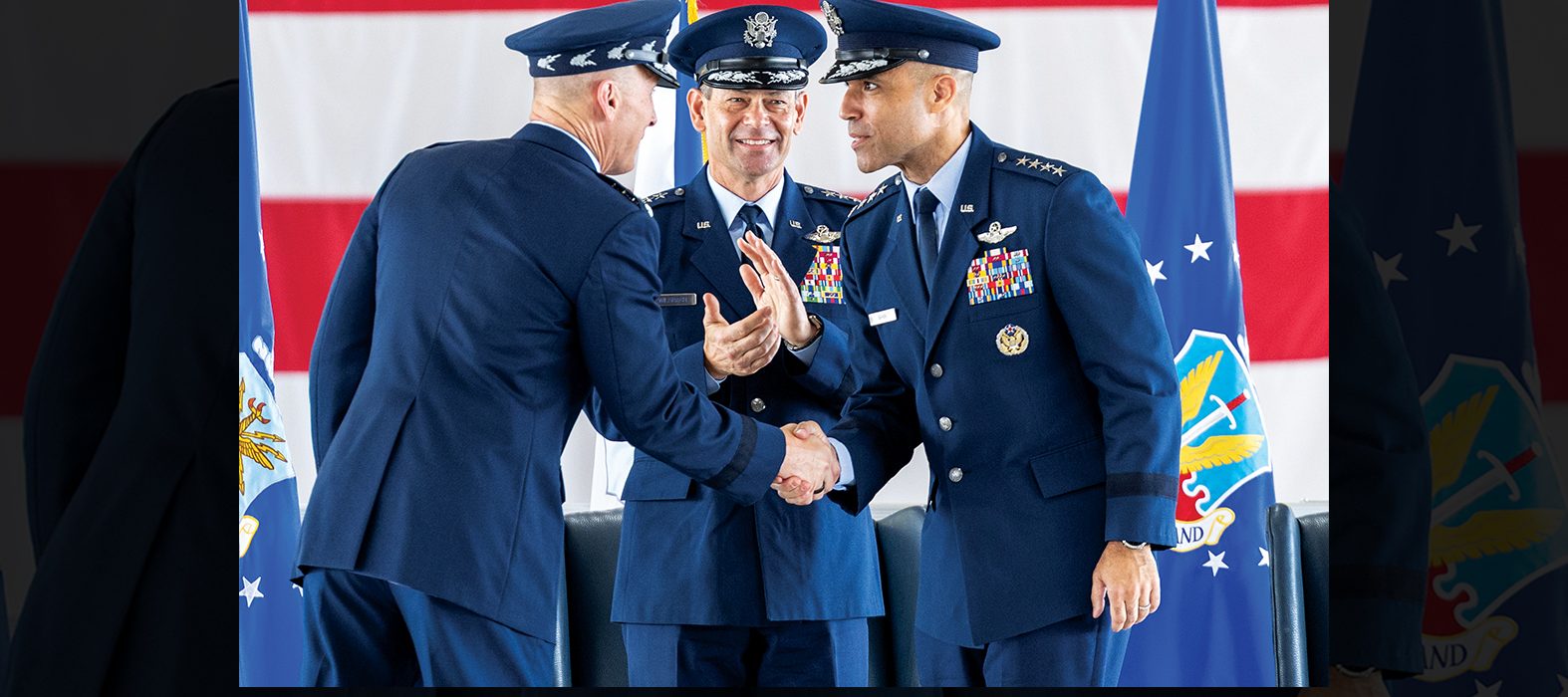Spain Takes Charge at ACC
By Chris Gordon
Gen. Adrian L. Spain succeeded Gen. Kenneth S. Wilsbach Aug. 11, marking his ascension to the four-star ranks at one of the Air Force’s largest and most far-reaching commands.
In a ceremony presided over by Air Force Chief of Staff Gen. David W. Allvin, just a week before he announced his intended retirement, the Chief emphasized the need for fighter aircraft and air superiority in the face of growing threats from China in the Pacific and its ally, Russia, in Europe.
“We have continuously looked at the aggression and the coercive activities of the People’s Republic of China—that arc has not changed,” Allvin said. “After February [2022], when Russia invaded Ukraine, people started talking about how maybe air superiority was obsolete, it didn’t matter anymore, the battlefield had changed—not recognizing that it was the inability or the unwillingness to appropriately apply airpower that was as much the cause of that as anything.”
Wilsbach echoed the concerns and the idea that flexibility has always been a central facet of airpower. “We can’t just be a one-trick pony,” Wilsbach said. “We’ve got to be able to be agile and move to where the requirements of the globe matter.”
Spain, whose prior role was Air Force deputy chief of staff for operations—known as the A3—played a central role in developing the Air Force’s force management and training policies. Following the firing of former Air Force Vice Chief of Staff Gen. James Slife, he was the principal voice on the service’s readiness and modernization initiatives on Capitol Hill.
Air Combat Command is at the forefront of important Air Force doctrinal shifts, such as agile combat employment (ACE). Though ACE is a servicewide initiative to be able to operate in a more dispersed manner—primarily in the Pacific—Air Combat Command’s fighters are permanently based in the United States and deploy overseas.
“I truly believe that ACC is the heart and soul of our Air Force,” said Spain, a career F-22 and F-15 pilot who has spent around half his career in ACC. “We have a lot to focus on, but our primary focus must be on readiness—readiness of our aircraft, readiness of our aircrew, readiness to dominate the electromagnetic spectrum, readiness of all our Airmen and their families. … I’m not interested in arbitrary timelines or functional efficiency at the expense of warfighting effectiveness. We’ll get a little bit better today, so we are a little more ready tomorrow.”
Air Combat Command comprises more than 100,000 Airmen, 1,000 aircraft, and two dozen wings. Allvin’s vision tasked the command to have a special cross-functional role in improving readiness across the force. In May, ACC said it was changing how it measures and tracks fleet readiness, aiming to simplify the way it tracks and communicates the material condition of its airplanes with a system dubbed “Readiness Informed Metrics.”
RIM relies on three key numbers for each individual command level: Total aircraft; the number of aircraft needed to fulfill operational requirements; and the number available to meet those requirements. At the time, ACC Director of Logistics, Engineering, and Force Protection, Brig. Gen. Jennifer Hammerstedt, told Air & Space Forces Magazine RIM “really helps at the strategic level” to define a command’s ability to field forces “tail by tail, and go … ‘OK, we’ve got X number of aircraft down for maintenance. What are we doing? What is our plan? It kind of just jumps out a little bit differently.”
ACC also has been charged with leading increased training across the Air Force, expanding major exercises into Department-Level Exercise events. And it is the lead command developing Collaborative Combat Aircraft and the future sixth-generation F-47 fighter.
“The work the Chief and the Secretary [of the Air Force Troy Meink] are doing to focus on our foundational readiness is substantial, and it’s the right thing. But it’s going to take a while to manifest,” Spain said. “What we do between now and then will be decisive. We must be prepared and adapt now to maximize the opportunity for increased resources in the future.”
US Wargame in Pacific Tests New Air Mobility Comms Technology
By David Roza
ANDERSEN AIR FORCE BASE, Guam
A massive U.S. military exercise in the Pacific is exploring how adding new communications equipment to cargo and refueling aircraft can help coordinate large troop movements across thousands of miles of open ocean.
“We like to say flexibility is the key to airpower, right? That flexibility, the agility to adjust to a changing environment … gives us a great ability to maneuver,” Gen. John Lamontagne, the head of Air Mobility Command, told Air & Space Forces Magazine July 16 in an exclusive interview. “I think it all comes down to communication.”
Military aircraft depend on systems that translate incompatible communications technologies to decipher data moving among them, satellites, and ground stations. But in a potential fight with China, those dependencies become weak points that can be jammed, intercepted, and disrupted. Mobility Guardian 2025, AMC’s biennial combat training exercise, focused on fighting through such challenges.
Transports, tankers, and ground crews practiced rapid deployments as a force, rather than individually, deploying from home stations across the continental United States. About 85 mobility aircraft and 2,245 Airmen have participated in the exercise so far this year, moving more than 7,000 troops and 5,000 tons of supplies and equipment in seven days, an AMC spokesperson said.
Pacific-Scale: 6,600 Miles, 10 Tankers
About 400 U.S., German, and French paratroopers launched a simulated air assault July 13, departing Joint Base Elmendorf-Richardson, Alaska, aboard six C-17 transport jets, and pulling their rip cords in the dark sky over Charters Towers in northeastern Australia, 6,600 miles south of their departure. Along the way, those C-17s met up with an air bridge of 10 Air Force tankers—a mix of KC-46s and KC-135s—over the Pacific, four hours north of Guam, where they took on more than 470,000 pounds of fuel.
Timing that rendezvous was part of a 24-hour, nearly nonstop evolution. “For tankers, the challenge is ‘how do you link up with your receiver unit?’ And that’s a lot of what we do,” said Lt. Col. Kelsey Payton, who oversaw air refueling operations for the Department-Level Exercise (DLE) wargame, which involved more than 12,000 troops, hundreds of aircraft, and at least six international partners across the Pacific.
Though conceptualized months ahead, planners had only about a day to lay down the nuts and bolts of the refueling, such as radio frequencies, takeoff time, and flight plans. “We have a dedicated team of mission planners that come together and they say, ‘Hey, here’s the tasking, build the plan,’” she said.
Those things are relatively easy when operating in familiar territory with familiar teammates. Taking the show on the road makes establishing and maintaining tactical control harder, because it’s not immediately clear who to call to move cargo or get aircrew to and from their sleeping quarters.
“I spent most of my first few days here walking and driving to different agencies on base just putting faces to names, getting phone numbers, and knowing who to talk to,” Payton said.
Those relationships help when things inevitably go sideways, like when weather or airspace restrictions force changes in flight plans. Indeed, only about half the tankers that were originally supposed to support the DLE showed up, because the rest were diverted to support real-world operations, including Operation Midnight Hammer, the June attack on Iran’s nuclear facilities that took place shortly before the DLE kicked off.
Having fewer tankers available injects additional realism into the exercise; if the transport mission calls for 12 tankers, for example, but only 10 are available, then planners have to figure out how to make do with less.
“I’ll ask, ‘Hey can we come down on the ask?’ [and the answer comes back] ‘Oh yeah, we can come down 10,000 pounds on every jet.’ OK perfect, I can still meet your requirement,” she said.

Planning a 10-ship formation, a rarity in the tanker world, posed other challenges, especially since none of the 10 tankers had been in theater more than 24 hours before takeoff.
“What makes this unique is the amount of aircraft,” said Capt. Luke Hartings, who commanded one of six KC-135s. Hartings had flown in the night before, as did the tanker he was piloting. Maintainers worked all night to get the 60-something-year-old jet mission ready.
“They work miracles,” Payton said, who worked into the night to ensure Airmen working the mission had the food, water, and other needs on board to make the mission successful.
“We operate all around the world, and when you do that, you have to have a level of trust with your folks,” she explained. “They know the mission, they know the intent, they studied up, they got the briefing this morning, and now they’re ready to go out and do it.”
The crews didn’t disappoint. Payton would say later the mission went “extremely well,” thanks in part to a new piece of gear: the backpack-size Airlift Tanker Open Mission Systems [ATOMS] kit that acts as a mobile hot spot for secure and commercial Wi-Fi in flight. The ATOMS kits let the two formations talk with each other over long distances and switch up their plan midflight for a smooth rendezvous.
“The exercise demonstrated the benefit of having at least one connected aircraft in each formation,” Payton said. “For future exercises, we would want to schedule that requirement ahead of time, allowing planners to build contingency courses of action leveraging the ability to connect.”
But the lieutenant colonel and the rest of the tanker showrunners didn’t have time to celebrate, as they still had a long list of missions to plan.
“The pace is fast, and you’re like ‘dang it, we’re going nonstop,’” Payton said. “But I think it’s because that’s what our mission is: right people, right place, right time. At the end of the day, everyone needs Air Mobility Command.”



